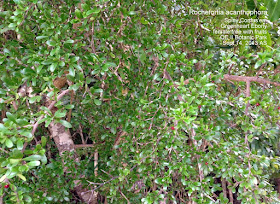Shake Hand Trees
in the Cayman Islands have spines on the trunk. Several unrelated species have this common name. Imagine walking through Cayman's dry, very rocky woodlands, watching carefully where you are putting your feet, holding on to tree trunks for support as you go. If you grab on to a spiny trunk, the pain will probably make you shake your hand! Some other shrubs/small trees with spiny branches and little leaves may be confused with the Shake Hand shrubs/small trees, which may look similar.
Shake Hand Tree, Xylosma bahamensis, (Britton) Standl. in Tropical Woods 34:41. 1933,
dioecious, Endangered, Family: SALICACEAE.
Grand Cayman, northern Bahamas (and Cuba?).
Intricately-branched Shake Hand trees have sharp spines on the trunk
as well as the branches.
P. Ann van B. Stafford, Grand Cayman, Nov. 23, 2006
Spiny Confus’em, Greenheart
Ebony - Rochefortia acanthophora
BORAGINACEAE, dioecious, shrub/small tree
FLORA of the CAYMAN ISLANDS
by George R. Proctor, 2nd. Ed. 2012
Securinega acidoton,
Green Ebony, EUPHORBIACEAE p.438 now determined to be Rochefortia acanthophora, Greenheart Ebony, BORAGINACEAE p.570
Spiny Confus'em, Greenheart Ebony - Rochefortia acanthophora, BORAGINACEAE.
Dioecious - female tree with tiny ripe, red fruits.
Queen Elizabeth II Botanic Park, by the lake.
Grand Cayman, Greater Antilles and Antigua.
P. Ann van B. Stafford, Sept.14, 2013
There is another tree on the Woodland Trail, by the signpost.
Spiny Confus'em, Greenheart Ebony - Rochefortia acanthophora, BORAGINACEAE.
Dioecious - male and female flowers on different plants - shrub/small tree.
Flora of the Cayman Islands, Proctor, 2012 p.570, Pl.55
Greater Antilles and Antigua.
Grand Cayman, Ann Stafford, Sept.14, 2014
Queen Elizabeth II Botanic Park photos
SPINY
CONFUS’EM – my common name for Rochefortia
acanthophora, BORAGINACEAE, p.570. Grand Cayman, Greater Antilles and Antigua, in rocky woodlands.
It
was previously thought to be Securinega
acidoton Green Ebony EUPHORBIACEAE p.438: ‘Cayman specimens are all
sterile; flowering and/or fruiting specimens are needed.
Sideroxylon horridum
(Green Thorn) resembles both Securinega
acidoton and Rochefortia acanthaphora
and needs to be considered when making an identification.'
FLORA
2nd. Ed. 2012 Plate 37 #1 - my photo sent to Kew in April 2006, labeled 'Securinega acidoton', Vixville, West Bay,
Aug.10, 2003. It is Rochefortia
acanthophora.
Eventually
I found flowering and fruiting specimens. In Oct. 2006, dried specimens with
ripe red fruits, 4 seeds, were sent to Dr. Proctor in Jamaica. He
confirmed that Spiny Confus'em could not therefore be Securinega acidoton EUPHORBIACEAE,
because it did not have 3-locular fruits.
Spiny Confus'em, Greenheart Ebony - Rochefortia acanthophora, BORAGINACEAE.
Dioecious. Fruit with 4 seeds.
Grand Cayman, Sept.17, 2006. Greater and Lesser Antilles. P. Ann van B. Stafford
Plate
55
#3
BORAGINACEAE Rochefortia acanthophora (AS) side-by-side with Sideroxylon horridum for comparison
#4
BORAGINACEAE Rochefortia acanthophora (AS) tiny staminate and pistillate flowers
of dioecious shrub/small tree
#5
BORAGINACEAE Rochefortia acanthophora (AS) leaves with tiny unripe (green) and
ripe (red) fruits
Spiny
Confus'em - Rochefortia acanthophora Greenheart Ebony, has been mistaken for Sideroxylon horridum – Green Thorn,
SAPOTACEAE in the past, which I find is less common. It has also been mistaken
for Xylosma bahamense - Shake Hand
tree, SALICAECEAE.
Plate
25
#1
SAPOTACEAE Sideroxylon horridum big
tree - no initials, but it’s my photo.
#2
SAPOTACEAE Sideroxylon horridum (MC)
– may be Rochefortia acanthophora -
Spiny Confus’em , which has twigs that are
brittle and break off easily. It grows in all districts of Grand
Cayman and I find is more common than Sideroxylon horridum - with twigs that are rigid and reddish and
the thorns SHARP! The rigid, sharp thorns were used for repairing fishing nets.
Green Thorn - Sideroxylon horridum, Endangered, SAPOTACEAE,
very sharp, rigid thorns.
Cayman Islands, Cuba and Haiti.
P. Ann van B. Stafford, North Side, Grand Cayman, Nov. 10, 2002
Xylosma bahamensis
- Shake Hand, SALICACEAE, dioecious shrub/small tree, Endangered p.319,
Pl.21 #3 and 4.
Shake Hand -
Xylosma bahamensis, SALICAEAE.
Dioecious
Critically Endangered shrub/small tree.
Fruit on female plant, QE II Botanic Park Woodland Trail.
Flora of the Cayman Islands, Proctor, 2012 p.319, Pl.21;
Wild Trees in the Cayman Islands p.84/212.
Range: Grand Cayman and northern Bahamas only.
Ann Stafford, Feb.13, 2010.
Spiny Confus'em, Greenheart Ebony - Rochefortia acanthophora and
Shake Hand - Xylosma bahamense compared.
Both are dioecious - male and female flowers grow on different plants.
The flowers do not have petals.
Both these shrubs/small trees grow in the Queen Elizabeth II Botanic Park.
Proctor 2012: p.570 and 319
Grand Cayman, P. Ann van B. Stafford Sept.14, 2013.
Shake Hand tree - Zanthoxylum coriaceum, RUTACEAE,
Critically Endangered,
North Side, Grand Cayman, Feb. 23, 2002
Zanthoxylum caribaeum
- Shake Hand Three, RUTACEAE.
Zanthoxylum sp, now identified as Z. caribaeum, RUTACEAE.
Mastic Trail, Grand Cayman, July 27, 2008. P. Ann van B. Stafford
Adelia ricinella
– Wild Lime, EUPHORBIACEAE dioecious shrub, Critically
Endangered, p.455, Fig.164, pl.39 #5.
Adelia, Wild Lime - Adelia ricinella, dioecious, EUPHORBIACEAE.
ALTERNATE leaves, Critically Endangered shrub.
Range: Cayman Islands, West Indies south to Tobago and Curacao.
Beach Bay Heights, Grand Cayman, Ann Stafford, April 6, 2003.












